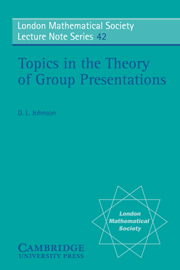Book contents
- Frontmatter
- Contents
- Preface
- Chapter I Free groups and free presentations
- Chapter II Examples of presentations
- Chapter III Groups with few relations
- Chapter IV Presentations of subgroups
- Chapter V The triangle groups
- Chapter VI Extensions of groups
- Chapter VII Small cancellation groups
- Chapter VIII Groups from topology
- Guide to the literature and references
- Index of notation
- Index
Chapter VIII - Groups from topology
Published online by Cambridge University Press: 28 January 2010
- Frontmatter
- Contents
- Preface
- Chapter I Free groups and free presentations
- Chapter II Examples of presentations
- Chapter III Groups with few relations
- Chapter IV Presentations of subgroups
- Chapter V The triangle groups
- Chapter VI Extensions of groups
- Chapter VII Small cancellation groups
- Chapter VIII Groups from topology
- Guide to the literature and references
- Index of notation
- Index
Summary
Nothing puzzles me more than time and space;
and nothing troubles me less, as I never think
about them.
(Lamb: Letter to T. Manning)As will already be plain to the erudite reader, the connections between the theory of group presentations and algebraic topology are both substantial and pervasive. Thus, for example, the triangle groups of Chapter V are essentially geometrical objects, homological methods play a crucial role in the theory of group extensions (Chapter VI), and Chapter VII illustrates the dependence of small cancellation methods on properties of planar graphs. The former subject relies on the latter, both for methods and for examples and this interrelationship has been increasingly in evidence since the inception of both.
A vital bond, in one direction at least, is forged by the fundamental group of a space and we begin with a study of this, carrying with us the idea of a surface for a paradigm. Since the theory of compact connected n-manifolds is in a sense algebraically complete when n = 2, we go on to study some examples in the case n = 3. We make no apology for our emphasis on algebraic structure and bias towards computational techniques, nor for the fact that we are merely splashing about on the surface of what are really very deep waters indeed.
- Type
- Chapter
- Information
- Topics in the Theory of Group Presentations , pp. 245 - 290Publisher: Cambridge University PressPrint publication year: 1980



